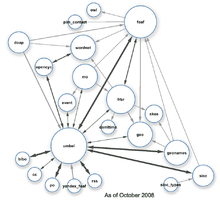UMBEL
| Developer(s) | Structured Dynamics, Ontotext |
|---|---|
| Initial release | 16 July 2008 |
| Stable release | UMBEL 1.05 / 21 May 2012[1] |
| Written in | OWL 2, SKOS |
| Type | Semantic Web, linked data |
| License | Creative Commons Attribution 3.0 |
| Website | umbel.org |
UMBEL, short for Upper Mapping and Binding Exchange Layer, is an extracted subset of OpenCyc, providing the Cyc data in an RDF ontology based on SKOS and OWL 2. According to its Web site,[2] UMBEL "is designed to help content interoperate on the Web."
UMBEL has two main functions:[3]
- It is an upper ontology of about 28,000 reference concepts, designed to provide common mapping points for relating different ontologies or schema to one another, and
- A vocabulary for aiding that ontology mapping, including expressions of likelihood relationships distinct from exact identity or equivalence. This vocabulary is also designed for interoperable domain ontologies.

UMBEL is a prominent class structure used in Linked Data, along with OpenCyc, YAGO, and the DBpedia ontology. Because it is a strict subset of OpenCyc concepts and relationships, mappings to UMBEL can take advantage of the reasoning engines within Cyc.
Including OpenCyc, UMBEL has about 48,000 formal mappings to DBpedia, PROTON, GeoNames, and schema.org, and provides linkages to more than 2 million Wikipedia pages (English version). All of its reference concepts and mappings are organized under a hierarchy of 33 different "super types",[4] which are mostly disjoint from one another. As of version 1.05, UMBEL was split into "core" and "geo" modules (for when the GeoNames mappings are not used).[5]
UMBEL was first released in July 2008. Its first production-grade and stable release was version 1.00, released in February 2011.[6] Its current release is version 1.05.[5]
UMBEL[7] is maintained by Structured Dynamics.[8]
See also
Notes
- ↑ "New UMBEL v 1.05 Links to schema.org, GeoNames". UMBEL Web site. 21 May 2012.
- ↑ http://umbel.org/home
- ↑ Bergman, M.K. UMBEL: A Subject Concepts Reference Layer for the Web. Retrieved 2010-04-02.
- ↑ See Annex G in the UMBEL specifications.
- ↑ 5.0 5.1 See the release announcement.
- ↑ See the UMBEL v 1.00 release announcement.
- ↑ http://umbel.org/resources/about
- ↑ See http://www.ckan.net/package/umbel; various downloads as part of the linked open data cloud may also be obtained from this link.
External links
- Main page for UMBEL
- UMBEL interactive subject concept explorer
- UMBEL specification, and its accompanying Annexes A - I
- Other UMBEL downloads and documentation
- UMBEL discussion group
| ||||||||||||||||||||||||||||